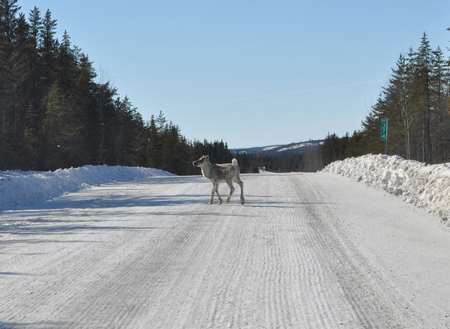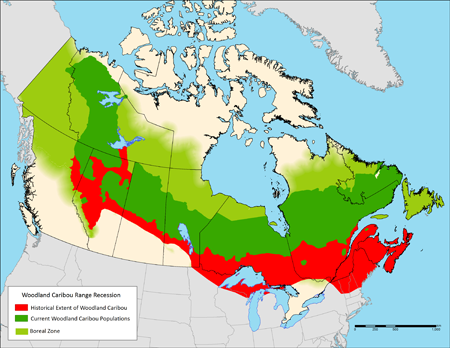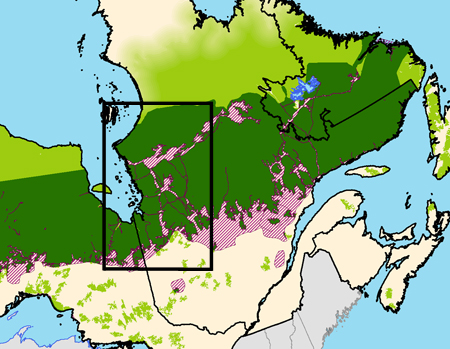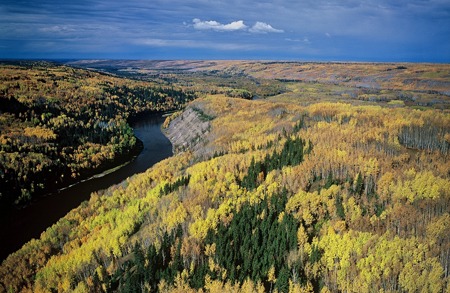
Dangerous crossing for a woodland caribou
Credit: Valerie Courtois, Canadian Boreal Initiative
It seems as though woodland caribou continue to lie at the center of environmental issues in Canada. The elusive, antlered marvels that mostly stake out grounds in old growth boreal forest continue to struggle against the one-two punch of human encroachment and the effects of climate change.
Its range is nearly half of what it was historically and now a mere 20,000-30,000 are left in the wild, almost exclusively confined to the northern intact portions of Canada’s boreal forest.

Woodland caribou have lost around half of their range
Credit: International Boreal Conservation Campaign
Just a few short weeks since a team of scientists (myself included) authored a science and policy briefing paper outlining the difficult state of woodland caribou populations and the factors behind their decline, two new regional stories about woodland caribou have popped up that reinforce the notion that if dramatic action is not taken soon, we could be the generation that oversaw the downfall of this amazing species.
In Quebec, a report by Global Forest Watch Canada found that industrial development has been dramatically expanding in the James Bay region, a part of the woodland caribou range previously considered fairly secure and home to Cree communities who have lived there for thousands of years. The region is within the lands of the Cree Regional Authority.

Woodland caribou habitat in the James Bay region of Quebec has been increasingly affected by development (intact habitat in dark green and impacted habitat in shaded purple)
Credit: International Boreal Conservation Campaign
Specifically, the Global Forest Watch Canada report found that industrial impacts in caribou habitat have already risen from 219 km2/year (2002-2009) to 259km2/year (2009-2010), but perhaps worse is that they are projected to rise to 466 km2/year by 2013. Overall, a combination of industrial development and wildfires will likely affect 32% of woodland caribou habitat in the region—a threshold that, as reported in our recent paper, once crossed often signals the beginning of steep declines in woodland caribou. The lands of the Cree Regional Authority in the James Bay region (Eeyou Istchee) will likely pass this mark in the next several years, meaning unless they can boost protection efforts in the region soon these populations will no longer be sustainable.

Clearwater River in Alberta, a rare glimpse of intact habitat in region
Credit: Garth Lenz
A skip westward takes us over to Alberta where a federal court recently ruled against the federal government, siding with a group of First Nations and environmental organizations concerned that some Alberta woodland caribou herds are headed towards extinction within 30-40 years without immediate intervention. Boreal populations of woodland caribou have been listed as “threatened” under the Species at Risk Act (SARA) since 2000, however the federal government has yet to apply the law to intervene in cases of the most threatened herds, several of which occur in Alberta. The court ordered the federal government to create a recovery strategy by September.
There are still great opportunities in both Quebec and Alberta to install effective caribou management strategies, but it will mean ditching the status quo. In Quebec, there are great opportunities for the government to support Cree protected areas proposals like that for the Broadback River-Lake Evans region to ensure that woodland caribou remain part of the Cree lands before development expands further.

The lucrative oil sands business is proving to be a disaster for caribou
Credit: David Dodge, Pembina Institute
In Alberta there is serious consideration going into the Lower Athabasca Regional Plan (LARP) in which the government will attempt to lay out a long-term vision for what activities and protections will occur. However, most of the proposals to date have been inadequate in the both the percentage of land protected and the specific areas that would fall under protection (see LARP report by Global Forest Watch Canada or Caribou Management Options report by the Alberta Caribou Committee). Many environmentalists and First Nations are worried that the plan will strongly favor development over caribou and the environment, and are worried the plan is just another form of greenwash.
Bold steps and bold leadership will surely be needed to rescue this iconic species from eventual collapse, but we increasingly have the tools and science to do it. Now the question is whether Canadian leaders will step up to the challenge.

